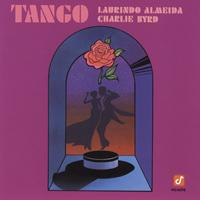Two Guitar Greats Dance Around a Latin Beat
The Concord catalog is filled with great sounding recordings made by top tier artists in the later phases of their careers. There's nothing wrong with that. It's to label founder and producer Carl E. Jefferson's credit that he had a jazz label vision and saw it through at a time when jazz was on the decline commercially.
Mainstream commercial choices like this title, along with superb sonics helped the label thrive. The analog resurgence and the label's willingness to license, has given the catalog a new lease on life.
These two guitar greats work string wonders together, though if you don't like tangos, you're best off staying away. As the somewhat defensive liner notes say, “When was the last time you listened to the tango with any seriousness? I know. Me too. As soon as I hear that familiar drum roll, I want to break out in laughter.”
However, since the notes were written and the album originally released in 1985, the tango has undergone a resurgence in popularity thanks to a new appreciation for Astor Piazzola, one of tango's strongest musical supporters. While we sometimes think of the genre in comedic terms-the overdramatic dance moves, the rose stem in the teeth-the music sprung from the violent slums of Buenos Aires, and other Argentinian urban areas. It was considered immoral and too sexually suggestive for the common good. It was popular among prostitutes and performed in brothels. The Archbishop of Paris threatened excommunication at the turn of the last century for any Catholic caught doing dancing it. Soon tango became mainstream, and then it became a joke, only to be re-discovered in recent years.
These two jazz guitar giants romp through a series of (too) familiar tunes such as Leroy Anderson's “Blue Tango,” “Orchids in the Moonlight” and “Hernando's Hideaway” from the musical “Damn Yankees,” and some less than familiar songs. Byrd and Almeida trade off arranging credits. It's a shame who's playing in what channel is not divulged, but it sounds like Byrd on the left and Almeida on the right. They are backed sensitively by Chuck Redd on drums and Joe Byrd on bass.
The closely miked recording produces large sized guitars-especially if you crank up the volume inappropriately-but the basic sound is so pure, direct and enticing you'll forgive the Godzilla guitars.
Add a delicate touch of reverb to gel the mix and you have a pleasing, commercial guitar record that goes down easy and sounds wonderful.
However, if you really want to hear these two masters at their peak, do not pass up any of the Capitol Laurindo Almeida albums, particularly the mono ones from the 1950's, which are astonishing musically and sonically, and consider the Byrd Riverside albums as well.
I'd suggest Duets With The Spanish Guitar (Capitol P 8406), impressões do brasil (Capitol P 8381), and Villa-Lobos: Music For The Spanish Guitar (Capitol SP 8497). Actually, any record in this series on Capitol in either mono or stereo is recommended and usually they can be found for a few bucks.
As for Charlie Byrd, you can't go wrong with Bossa Nova Pelos Passaros (Riverside RS9436) or Charlie Byrd at the Village Vanguard(Riverside RS 9452), among others.


